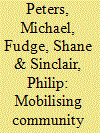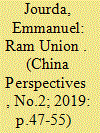| Srl | Item |
| 1 |
ID:
173379


|
|
|
|
|
| Summary/Abstract |
Ancient Singapore is often discussed exclusive of its cultural and historical context, a backward projection of the modern, independent city-state. Temasek is understood mainly in terms of being a maritime entrepôt with extensive trade connections. This research is interested in Temasek as a proto-historic Malay port-city, namely its social, political and economic organisation. It is an aspect of early Singapore, and of the Malay World, in general, we know very little about. However, more than three decades of archaeology have provided a wealth of data related to daily life in the settlement and the data has provided hints of a diverse sociocultural landscape. This study focuses on the relationship between metal production and social organisation, and employs a conceptual and interpretative framework that is both multidisciplinary and cross-cultural. Craft production is as much a social and political phenomenon as an economic and technological one, and studies of production systems can shed light on issues of power and control over resources and labour. The data suggest the presence of a social stratum that could generate and mobilise resources independent of the ruling elite. Metals were rare and valuable commodities during this period, however, the ruling class in Temasek did not appear to control nor restrict production of iron and copper-based goods as it did with glass. The results are by no means the final word on ancient Singapore or Malay society. Instead it provides a provisional model that can be tested with archaeological data, refined and expanded as more material becomes available.
|
|
|
|
|
|
|
|
|
|
|
|
|
|
|
|
| 2 |
ID:
101451


|
|
|
|
|
| Publication |
2010.
|
| Summary/Abstract |
Over the last decade the important role that local authorities can play in catalyzing community action on climate change has been repeatedly emphasised by the UK Government. The paper examines this policy context and explores the options available to local authorities in terms of reaching and engaging their communities. The type of progressive response shown by some UK local authorities is illustrated with empirical evidence gathered through a study conducted in the London Borough of Islington focusing on their recently established 'Green Living Centre'. The results confirm interest in this major council-led community initiative, with positive attitudes expressed by the majority of those questioned in terms of the advice and information available. However, it is also clear that many participants had preexisting pro-environmental attitudes and behavioural routines. Results from a broader sample of Islington residents indicate a substantial challenge in reaching the wider community, where enthusiasm for sustainability change and interest in this type of scheme were more mixed. The prospect for local government in addressing this challenge - and their ability to trigger and capitalize upon concepts of social change at the community level towards a lower carbon future - is discussed in the final part of the paper.
|
|
|
|
|
|
|
|
|
|
|
|
|
|
|
|
| 3 |
ID:
168020


|
|
|
|
|
| Summary/Abstract |
The Ram Union is a non-profit social organisation established in 2003 in Zhejiang Province. Its transformation from a local entity into an international NGO tells us about the methods implemented by the Chinese Communist Party (CCP) to accompany the development of popular associations or minjian, which appear to be external to the Party but which in fact are fully sponsored by it. Studying such organisations is a complex matter, as they appear to act in a benevolent and apolitical manner, while being completely integrated within the political and social apparatus of the Party-state (Youth League, volunteers, United Front, ministry of Civil Affairs, etc.). The historical trajectory of the Ram Union thus gives us insight into the CCP’s overlooked strategy of hybridisation, involving mass organisations that came out of the revolutionary period and charitable groups embodying modern Chinese society. This strategy is designed to occupy the social arena and forestall the emergence of an autonomous Chinese civil society in the People’s Republic of China (PRC) or among the Chinese diaspora overseas.
|
|
|
|
|
|
|
|
|
|
|
|
|
|
|
|